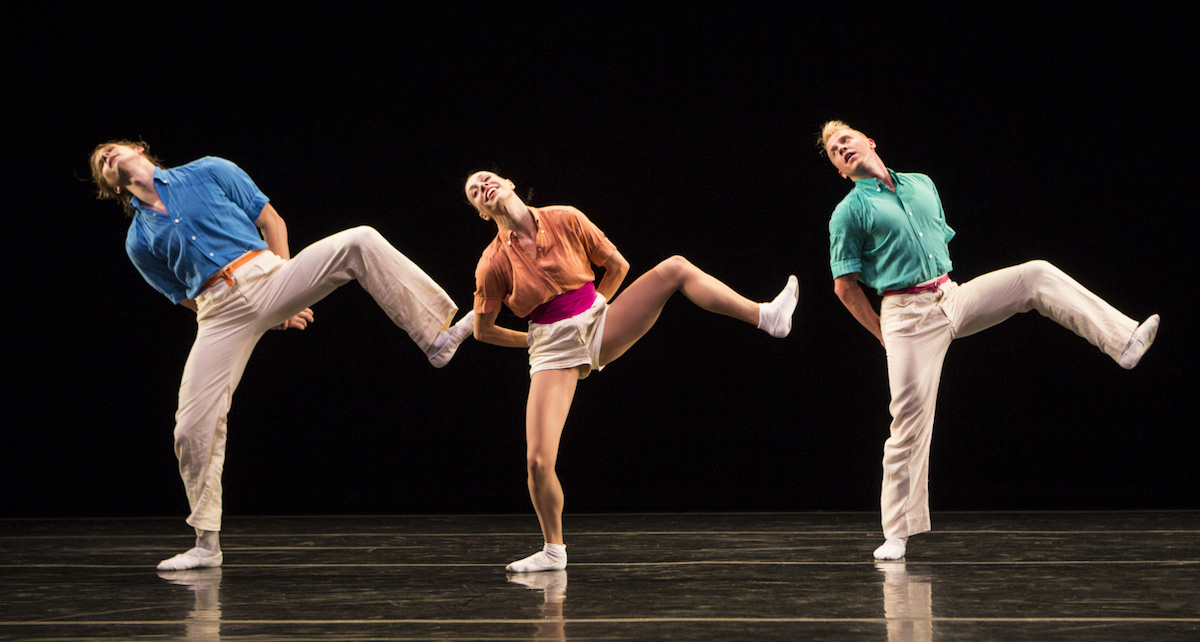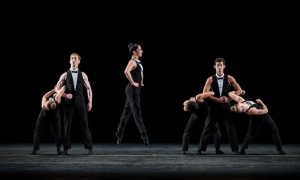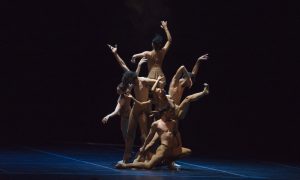The Joyce Theater, New York, NY.
Wednesday, July 20, 2016.
Twyla Tharp’s two-week run of Twyla Tharp and Three Dances reminds us why dance is so great…and special…and vital. It can be an aesthetically pleasing, uplifting art form that exists for a fraction in time until the next moment comes on. And Tharp has continuously found ways to keep us in the moment, keep her dancers alive and present on stage, and simply transport us, not to mention humor us (an added plus).
The nine-member ensemble excels in all three works on the program, and vivid costumes and music complete Tharp’s scenescapes.
Country Dances (1976) is flirtatious, colorful, at times comical. The Western story ballet for four dancers – Kaitlyn Gilliland, Amy Ruggiero, Eva Trapp and their lonely lad in distress, long-time Tharp dancer John Selya – uses classical vocabulary intertwined with fancy footwork characteristic of line dancing, along with infinite swoops and spins. The use of such classically trained ballet dancers in Tharp’s work makes for much clarity.
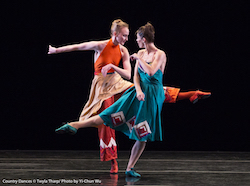
Kaitlyn Gilliland and Eva Trapp in Twyla Tharp’s ‘Country Dances’. Photo by Yi-Chun Wu.
The ladies playfully dance with and around Selya, and he performs one-handed push-ups and jumping tricks in an effort to impress the girls. The long Gilliland stands tall and striking in her bright orange costume by Santo Loquasto, and she remains a standout performer for the evening. And Ruggiero’s expressiveness and sweet smile make us believe that the dancers, too, are enjoying this experience. Country Dances is musical, pleasing and full of personality.
The evening’s premiere, Beethoven Opus 130, performed to music of the same name, opens with the dancers in black personalized Norma Kamali costumes. The work is strongly based in the classical – classical strings and technically-demanding, bravura balletic vocabulary.
Matthew Dibble is the central focus – he and partner Gilliland dressed in grayer hues. They perform a pas de deux, as three other couples dance in the background. Their partnership is interrupted by the striking Nicholas Coppula’s bare-chested entrance, as he crawls across the stage and takes Gilliland.
Interluded by exciting lifts, energetic ensemble work and slow, intimate duets, Dibble re-enters alone on a dark stage, raising his arms, before, one by one, dancers sail past him. Gilliland and Dibble are reunited, before Dibble, too, bares his chest and repeats Coppula’s earlier movements. But this time, the air between them is thick, and then Dibble is left alone. The cast brings him to lay on the floor, where he remains alone.
With a small cast and energetic choreography, the dancers’ stamina becomes impressive. But the peak of that is in “Book I” of Brahms Paganini (1980), when Reed Tankersley performs an extended solo, seeming to outlast anyone’s energy but his own. The solo is long but never repetitive or boring. Tankersley, dressed in all white by Ralph Lauren, is strong yet soft, with endless suspended relevés and beautiful flowy turns. The choreography is musical (set to Variations on a Theme by Paganini, Opus 35 by Johannes Brahms), accented by arms, hands and breathtaking balances. Tharp’s choreography of infinite swirls and twirls – using all parts of the body – are sometimes reminiscent of ice skating.
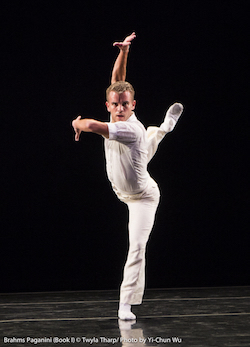
Reed Tankersley in Twyla Tharp’s ‘Brahms Paganini’. Photo by Yi-Chun Wu.
Although we see the sweat and hear his breathing, Tankersley never seems to tire and always appears in control, almost nonchalant. It’s an impressive duration of time and consistency, through to the very last moment of a lingering balance.
“Book II” brings along the rest of the cast, dressed in bright, summery tops and white shorts or pants. The dancers’ rapport is again playful and sweet, and Tharp inserts moments of slapstick – one dancer literally slapping another on the rear.
The ending scene – females caught upside down by the men – sums up what Tharp offers in this program: that dance is enjoyable, thrilling, and can turn you right-side-up or upside-down. I’ll take more of that.
By Laura Di Orio of Dance Informa.
Photo (top): Nicholas Coppula, Amy Ruggiero and Daniel Baker in Twyla Tharp’s ‘Brahms Paganini’. Photo by Yi-Chun Wu.


